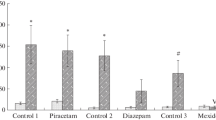Abstract
A study was carried out of the actions of haloperidol, trifluperidol, nitrazepam and chlordiazepoxide upon the behavioral and EEG responses during the stages of reinforcement and differentiation of avoidance conditioning in cats with chronically implanted electrodes.
The behavioral conditioned response was characterized by the presence of both attentional and emotional components. During reinforcement the emotional component was selectively depressed by all the administered compounds, while the attentional one and the EEG conditioned response were depressed only after the highest doses of haloperidol and trifluperidol. In the differential conditioning the same changes were present during the responses to the reinforced stimulus, although the conditioned responses were more sensitive to the disrupting effects of the drugs and a selective activity on the emotional component did not appear after the benzodiazepine derivatives administration.
During both paradigms the EEG arousal patterns very frequently showed a delay after the presentation of the conditioned stimulus and were characterized by lower frequencies and higher amplitudes when compared with placebo.
It is suggested that the selectivity of action of the butyrophenone and benzodiazepine derivatives on the emotional component of the conditioned response could be related with a specific action on neural substrates located in the limbic system.
Similar content being viewed by others
References
Chin, J. H., Killam, K. F.: Comparison of chlorpromazine, trifluoperazine and pentobarbital on conditioned arousal to reticular stimulation in cats. Psychopharmacologia (Berl.) 8, 41–59 (1965).
Delgado, J. M. R., Roberts, W. W., Miller, N. E.: Learning motivated by electrical stimulation of the brain. Amer. J. Physiol. 179, 587–593 (1954).
Favale, E., Loeb, C., Parma, M., Rossi, C. F., Sacco, G.: Effets de la stimulation de structures du tronc cérébral sur le comportement du Chat. Neuro-chirurgie 6, 89–91 (1960).
Hunsperger, R. W.: Affektreaktionen auf elektrische Reizung im Hirnstamm der Katze. Helv. physiol. pharmacol. Acta 14, 70–92 (1956).
Key, B. J., Bradley, P. B.: The effect of drugs on conditioning and habituation to arousal stimuli in animals. Psychopharmacologia (Berl.) 1, 450–462 (1960).
McLean, P.: The limbic system and emotional behavior. Arch. Neurol. (Chic.) 73, 130–142 (1955).
Monti, J. M., Hance, A. J.: Effects of haloperidol and trifluperidol on operant behavior in the rat. Psychopharmacologia (Berl.) 12, 34–43 (1967).
— —, Killam, K. F.: CNS effects of haloperidol (McN-JR-1625). Fed. Proc. 25, 229 (1966).
Nakao, H.: Emotional behavior produced by hypothalamic stimulation. Amer. J. Physiol. 194, 411–418 (1958).
Niemegeers, C. J. E., Janssen, P. A. J.: A comparative study of the inhibitory effects of haloperidol and trifluperidol on learned shock-avoidance behavioral habits and on apomorphine-induced emesis in mongrel dogs and in beagles. Psychopharmacologia (Berl.) 8, 263–270 (1965).
Olds, J., Milner, P.: Positive reinforcement produced by electrical stimulation of septal and other regions of rat brain. J. comp. physiol. Psychol. 47, 419–427 (1954).
Papez, J. W.: A proposed mechanism of emotion. Arch. Neurol. Psychiat. (Chic.) 38, 725–744 (1937).
Randall, L. O., Schallek, W.: Pharmacological activity of certain benzodiazepines. In: Psychopharmacology: A review of progress 1957–1967. D. H. Efron, ed., Publ. No. 1836, pp. 153–184. Public Health Service 1968.
Ross, N., Piñeyrúa, M., Prieto, S., Arias, L. P., Stirner, A., Galeano, C.: Conditioning of midbrain behavioral responses. Exp. Neurol. 11, 263–276 (1965).
Snider, R. S., Niemer, W. T.: A stereotaxic atlas of the cat brain. Chicago: The University of Chicago Press 1961.
Sommer-Smith, J. A.: Tone cessation as a conditioned stimulus. II. Inhibition. Electroenceph. clin. Neurophysiol. 23, 439–448 (1967).
Author information
Authors and Affiliations
Additional information
This study was supported by Grant MH 15754-01 from the National Institute of Mental Health.
Chlordiazepoxide (Librinm®) and Nitrazepam (Mogadon®) were kindly supplied by Roche Laboratories, Montevideo, Uruguay.
Rights and permissions
About this article
Cite this article
Ross, N., Monti, J.M. Effects of haloperidol, trifluperidol, nitrazepam and chlordiazepoxide upon conditioned midbrain behavioral responses. Psychopharmacologia 22, 31–44 (1971). https://doi.org/10.1007/BF00401464
Received:
Issue Date:
DOI: https://doi.org/10.1007/BF00401464



